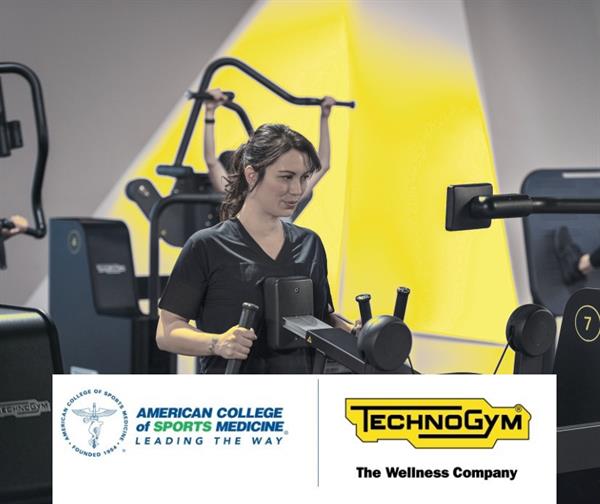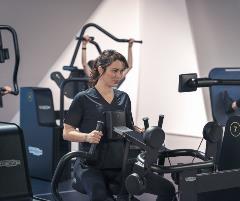Marco Narici, Ph.D. |
Dec.
26, 2019

Technogym and ACSM recently hosted an industry-presented webinar with Marco Narici, Ph.D., entitled Skeletal Muscle Adaptations to Concentric and Eccentric Loading. This is Part II of the Q&A.

Read Part 1 of the Q&A here.
Several questions were asked by attendees during the webinar and the answers pertaining to seniors, pennation angle and more are below.
Q: Would this Biostrength be beneficial to seniors? I work with older clients 70-95 years. Which of the 4 protocols would work best?
Definitely, yes. Considering the available evidences, the overloaded eccentric should be the ideal training mode with the elderly. However, we think that the viscous mode is very promising. We will conduct studies on that.
Q: Are there instances where you would recommend a different relative eccentric intensity other than 1.5x concentric, since 1.5x elicited equivalent EMG activation in VL?
The reason why we choose the 1.5-fold increase is because we tried several coefficients from 1.1 to 1.7 and we found that with 1.5-fold of the concentric we could achieve the same EMG level of the concentric load. However, to obtain a lower EMG activation a different ‘coefficient’ of increment, or decrement, could be chosen; even an eccentric load which is lower than the concentric if you don’t want to overload a muscle in case of muscular injuries.
Q: Increasing eccentric load in frail adults was mentioned as a benefit for this demographic. Is there any research supporting eccentric loading in reducing joint damage, for all human joints, regardless of age or ability?
Several studies have shown that training with eccentric loading, unless there are already joint problems, may be performed safely in older people using intensities up to 70 % 1RM. However, training load at 60% 1RM seems sufficient for achieving maximum protein synthesis, and thus gains in muscle mass and strength, in older people.
Q: During isotonic training, to what degree (if at all) is eccentric neural drive sustained (vs concentric levels) by lengthening the duration of the eccentric phase?
Ideally, the duration of the eccentric phase and that of the concentric phase should be similar (similar time under tension). There is no added benefit for motor unit recruitment in prolonging the eccentric phase
Q: Is there a higher fatigue perception using the higher eccentric loading? Is the subject able to push themselves to the same level or beyond normal concentric/eccentric movement?
We have conducted a study a few year ago using the RPE perceptions during concentric and eccentric contractions. When the strength gains induced by concentric/eccentric and eccentric training regimes were compared, greater strength gains were observed in the eccentric group (range 32.4% to 43.1%). Importantly, this increase in strength in the eccentric group was accompanied by significantly lower RPE ratings throughout the training period.
Q: Has the ability to overload more "effectively/efficiently" on a Biostrength machine been shown to transfer over to strength in a traditional back squat or leg press?
This hypothesis should be tested, but if you improve on a Leg Press Biostrength, it is highly possible that there will be a transfer effect over a more traditional Leg Press machine.
Q: Can you explain what “pennation” angle is?
This is a very funny question. We did not talk about the ‘pinnation’ angle but the ‘pennation angle.’ The pennation angle is the angle between the longitudinal axis of the entire muscle and its fibers. The longitudinal axis is the force generating axis of the muscle and pennate fibers lie at an oblique angle. As tension increases in the muscle fibers, the pennation angle also increases.
Q: The rowing machines that generate load via the water resisting paddles (instead of a fly wheel)—is that considered a "viscous load?" The water can be considered a viscous medium. However, water viscosity is very low and its variation with velocity is not significant from a training perspective.
Q: In terms of athletes, would overloading the eccentric phase while training ultimately result in a lowering of injuries because of a better activation of the fibers needed to slow down during change of direction or deceleration?
Training with eccentric overload would condition muscle and connective tissue to withstand greater breaking forces; this may potentially afford protection against injury. Recent evidence suggests that a single bout of eccentric exercise protects against muscle damage from subsequent eccentric bouts.
Q: Studies say that external cueing creates less neuromuscular activity, but equal force output, to internal cueing. Would you recommend people perform external cueing for the concentric phase but internal cueing for eccentric phase of a movement pattern to maximize strength response?
These techniques may be useful for rehabilitation of neurological patients, particularly if timing and speed of movement is a problem.
Q: So based on what you said about speed, would you suggest that concentric training would be better for performance?
Both CON and ECC training are needed for performance since many athletic disciplines involve repeated stretch-shortening cycles. Training only with CON contractions does not enable you to add contractile tissue longitudinally (addition of sarcomere in series). Instead, ECC training promotes longitudinal muscle growth, contributing to increased contraction speed.
Q: In the case of nerve injury and muscle wasting, is this machine helpful for regaining muscle?
Viscous training may be helpful to progressively recover muscle mass and function in this case provided that inflammation is under control and that movement does not exacerbate the pain symptoms.
Q: Would the added work in the eccentric phase and lengthening the muscle cells have any noticeable benefits on flexibility?
Some evidence seems to suggest that eccentric training is indeed an effective method of increasing lower limb flexibility but there is no firm evidence of this yet.
Q: In a low resource clinical setting, we have successfully used an accentuated eccentric protocol, defined as a concentric phase with BOTH legs for leg press leg extension and leg curl machines, while the lowering part (eccentric) was executed with ONE SINGLE leg only. What would you hypothesize is the advantage use of this machine will have over this more traditional method for ECC+ training?
The method you have used is clever and easy to be applied. However, the limitations of this method are:
- You cannot modulate the percentage of the eccentric overload (it would be always twice that of the concentric phase).
- You cannot apply this strategy to upper body movements (e.g., Lat Pull down, Shoulder Press, Chest Press, etc.) or to core muscle exercises (abdominal crunch, lower back).
Q: Please could you identify the largest advantage viscous training can have over Keiser air resistance machines? (Or can air resistance machines be considered a version of viscous training?)
Air is a viscous medium, but its viscosity is really very low and it is not dependent on movement speed. Moreover, viscosity cannot be increased.
Q: The Technogym leg press is great for strengthening the lower body. Is there a Technogym machine currently geared to strengthen the upper body?
Yes, the complete line is constituted by 9 machines: Leg Press, Chest Press, Lat Pull Down, Leg Curl, Leg Extension, Shoulder Press, Abdominal Crunch, Lower Back, Low Row.
Q: Does the increased muscle speed developed from eccentric training translate to speed in the concentric direction?
In theory it should, but of course this would require performing the movement during training as fast as possible to maximize recruitment.
Q: Just for clarification, why did you use a 3-second tempo for the concentric phase?
We had to standardize the protocol, so we decided to use the same tempo of the concentric phase.
Q: How are we going to get this machine easily accessible and usable throughout the fitness industry? Or will this be for rehabilitation mostly?
I think that this technology is suitable for both the rehabilitation as well as the fitness industry.
Q: You mentioned that faster velocity increases recruitment. How does this apply to eccentric, as opposed to dropping the weight? This applies mostly to the concentric phase only; it would instead be counterproductive to drop the weight in the eccentric phase.
Q: How can you avoid derecruiting motor units without a Technogym Biostrength machine? For people not able to go to a Technogym, how can they do this?
You should overload manually a standard machine before executing the eccentric phase. But it would be very complex to be done.
Q: How can I achieve a similar effect as the Technogym with body weight or more standard gym equipment?
There is no other equipment featuring all of those training modalities: isotonic, eccentric, viscous, elastic, overloaded eccentric.
Presenter: Marco Narici, Ph.D.

Prof. Narici directs the Neuromuscular Research Laboratory at the Department of Biomedical Sciences of the University of Padova (founded in 1222), Italy. He has more than 30 years’ experience in skeletal muscle research applied to training and detraining in young and older individuals.
View Related Technogym Content

Skeletal Muscle Adaptations to Concentric and Eccentric Loading Q&A Part 1